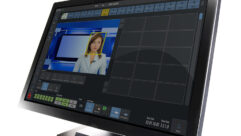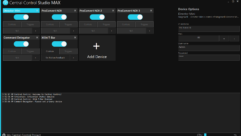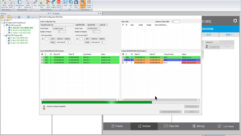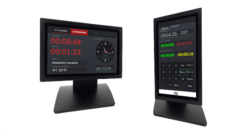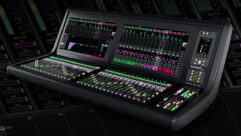
InfoComm 2014: Managing Multiple AV Facilities With A Central Control System
Jun 10, 2014 8:41 AM,
With Bennett Liles
Listen to the Podcast

Editor’s note: For your convenience, this transcription of the podcast includes timestamps. If you are listening to the podcast and reading its accompanying transcription, you can use the timestamps to jump to any part of the audio podcast by simply dragging the slider on the podcast to the time indicated in the transcription.
Among the highlights at InfoComm are the education courses from leading experts in the AV field. One of these is Christopher Maione, founder and managing partner in Christopher Maione Associates. His course is Managing Multiple AV Facilities With a Central Control System and we’re talking to him about that right now on the SVC Podcast.
Christopher, thanks for being here with us on the SVC Podcast, coming to us from Northport, N.Y., out there on Long Island. And you’re going to be teaching a course at InfoComm. I don’t want to steal any of your thunder from that, but it involves managing multiple AV facilities with a central control system. We both get into that, so it’s going to be fun talking about that with you.
Good afternoon, Bennett. A pleasure to be here.
Now how did you first see the need for enterprise level management of AV systems? You know, in your role as a consultant, how did this need sort of evolve to benefit your clients?
You know, when we first started designing AV systems for clients, there were perhaps two, three, or four AV systems in a particular building. As our clients grew, and as the need for AV systems grew, we began deploying systems in the magnitude of 30, 40, 50 conference rooms per building. I think the problem then got even more interesting when we started working with global clients and then the need for being able to monitor and manage AV systems across a network became even more apparent as our global clients wanted global control of their AV systems. [Timestamp: 2:00]
And it’s just been getting bigger all the time and changing faster and faster. I want to get your take on this though because in your experience, dealing with clients who totally rely on you to set it all up and keep it all running, what’s the most important single aspect of implementing a network-based control and monitoring system? What would you call rule number one?
Have as many systems as possible, as standard as possible. It makes it much easier to enterprise level monitor and control systems when they are similar based. If you can standardize on the type of equipment you use, if you can standardize on your control system, if you can standardize on your codec, that makes it certainly easier to deploy an enterprise-level system. I’m not saying if you don’t have any of those things – it’s not impossible, it just makes things a little more challenging. You’ve got a ping into a room with a little more detail in order to understand the particulars of that particular room and that particular system. [Timestamp: 3:00]
Yeah, it’s always good for the users when they see something familiar at the local control point in every room and that makes it a lot easier for support, too.
It is. You know when I was doing global rollouts all over the world, I always found it amazing that I could go to a cash machine – an ATM machine – on the streets of either London or Hong Kong or Singapore or Tokyo, and no matter what I could always get cash out of the cash machine because the user interface was more or less standardized. Even in some instances when the ATM wasn’t in my native language of English, you could still find your way around and get cash or check a balance or do something because of the familiarity of the user interface. We’re working towards a more unified look on control systems, and certainly on an enterprise level if users can go from one room to another, one floor to another, one building to another, or anywhere their corporate branches exist and be familiar with the same user interface for the control system, that I think makes everybody’s life a lot easier and it also makes, obviously, a monitoring an enterprise-level control system a lot easier to administer. [Timestamp: 4:11]
Talking about different languages, I think sometimes that the users feel that WE speak a different language when we get into terminology that we unconsciously assume that they understand when they really don’t.
Yep. You know unfortunately, we speak geek and most of our users don’t understand geek. And I’ve found the more successful folks in our industry are those who have learned to turn down the geekness and be able to interpret it and speak the language of the common corporate user or educational facility user or healthcare user. It’s important that we speak their language. I still believe that our control systems and our non-standard look of control systems is somewhat perplexing to the general AV user community and I’d like to see things further simplified and further standardized. [Timestamp: 4:59]
And nobody wants to look stupid when they’re up there in front of a crowd and they can’t get the system to work right. They may be reluctant to ask for help and I always encourage them to go to the room ahead of time if possible and turn on everything and just run through it one time. But the technology is moving pretty fast. What do you think an AV manager can do to best future-proof their systems?
Well, I think that we are now completely integrated with the IT network so I think as long as we continue to roll out equipment that is network-savvy, that does full reporting back on the network and continues to support enterprise level control, I think that’s the best we can do right now to future-proof at least the infrastructure side of our AV technologies. I think we’re always going to be chasing things like bigger, brighter projectors, larger, thinner flat panels, resolutions. You know, now the big push is 4K, 4K. We’ve seen signal formats go from analog to RGB to digital to HDMI to HDBaseT to AVB. Those technologies, I believe, are going to always continually evolve, but I think we have to focus on the infrastructure of our AV systems and I think that means taking an enterprise look and approach to the hardware that we specify. [Timestamp: 6:21]
InfoComm 2014: Managing Multiple AV Facilities With A Central Control System
Jun 10, 2014 8:41 AM,
With Bennett Liles
And no matter how simple you make it, there are so many potential pitfalls. What do you see as the most common mistakes in AV control system design?
There are three: 1. Over-complicated design; 2. Over-complicated design; and 3. Over-complicated design. And if you can avoid those three mistakes you can end up with happier users, simpler AV systems, typically lower-cost AV systems, and systems that function the way 90 percent of the user community needs them to function, not designed around that 10 percent of the anomalies that we run into. [Timestamp: 6:58]
Yeah, it seems to me that in a lot of cases, an AV firm may come in and install a system without being really familiar with the needs of the users or understanding the level of their capability in using it. So in your experience, what do you consider to be the most challenging environment for AV system operation, the corporate world, the university campus? Which is the most challenging?
I think the most challenging I have experienced has been the pressure of designing systems for financial services corporations where there is a lot of money involved and there are a lot of high-powered, demanding people under a tremendous amount of pressure and they really rely and depend on their morning meetings going off without a hitch, their video conference rooms, etc. This is their livelihood and in this environment in particular, there’s very little tolerance or patience for under performance – under performance from a consultant, under performance from a service provider, under performance from an integrator. None of that is tolerated. These are as close to mission-critical environments short of an actual mission-critical or network operations center that there are and these are demanding, demanding users. [Timestamp: 8:10]
That’s a high powered group of people who have to have it work now and work right every time.
Yeah. I mean any boardroom is probably the same. Too many important people gathered around a single room, a single table, for a limited amount of time. The last thing that anybody wants to do is look stupid in front of the board and have fundamental things like being able to show a Power Point presentation or dial a simple audio conference call end up as a big snafu. [Timestamp: 8:35]
And just the way they handle themselves in the presentation can affect the outcome of the whole thing. In my experience, I would say the university campus is a very tough place for AV as well because of the up-time, the wide range of users and the beating the hardware has to take. But you’re right, I don’t think I’d want to work in the financial world installing AV systems for those guys.
Yeah. I mean it’s every single day that the world turns the markets change and these systems communicate from London to New York, New York to Chicago, Chicago to California, California to Tokyo and then the world turns and these systems are essentially five days a week, 24/7.
And a lot of how well it works depends on how well it’s organized and administered and the organizational structure you have. What do you see as the most common organizational structure for AV and IT people?
Well you know, AV started out in the mailroom and then evolved somehow under facilities. Some of our larger clients now have separate AV departments and more and more we’re seeing those AV departments be rolled in or rolled under IT. I think the ideal model is to have a CIO who has a head of IT and a head of AV who are then tasked to work with each other. I don’t see AV completely getting rolled in 100 percent under IT, because I think supporting AV systems takes a very different model than supporting IT systems. [Timestamp: 10:00]
Certainly at the client level for sure. When these two get pushed together, how do you think IT managers, the people who keep the network up and running, see AV? Is it a pain in the rear or do they embrace as part of what they do?
Well just about every IT guy that is told they’re being handed AV, the first question they ask their boss is, ‘What did I do wrong?’ Because yeah, they view it as kind of a punishment because it does involve supporting users – client-facing business units – and it’s very different than supporting hardware. It’s very different than supporting servers and IDF’s and MDF’s and operating systems. Certainly there is a certain amount of interaction with the user at the desktop level, but it’s very different than supporting an AV system where we’re used to meet-and-greet and somebody to help us and make us feel comfortable with loading our laptop in or making the necessary connections, or establishing a multipoint video call. You become more of a concierge than you are just an IT support person. [Timestamp: 11:02]
So how can they help each other out? Is it just a question of the AV and IT people just giving each other an even break?
Yeah. I think the IT folks have to realize that AV have a different responsibility to the business units. They have a slightly different role because they are dealing with people. On the flip side, though, infrastructure systems are not very much different than IT systems and they should be managed and supported and maintained and tested just like any other IT infrastructure system. [Timestamp: 11:33]
When you’re sitting there hands-on at the control point and you have multiple AV systems in front of you, you can turn the displays on and off, you can read lamp hours and all that but beyond that, what do you think is the most handy thing to have remote control over?
Well the latest thing that I find everybody likes, although it does raise some concerns, is to put a small camera – a webcam – in the back of the room and give the technician who is monitoring and controlling the system a bird’s eye view to actually see what is going on. Now that raises a certain amount of privacy concerns about whether they can see in or hear in or see images that are on the screen, but it just becomes such a great tool for a technician to not have to run out and run into a room to see if someone’s in the room or to see what’s on the display or to be able to zoom in and see that the connection to the laptop is being made. So if you can get over the security aspect of it, that camera, I think, is a low-cost, excellent solution to provide a great tool to any AV support person. [Timestamp: 12:34]
Well, we sure agree on that because I’d love to have a camera in every classroom even if all it showed was the projection screen but professors hate the idea of having any cameras in the classrooms and it does get to be a big political thing.
Yeah. I mean short of that, you need a good dashboard so that when you ping into the room you truly get good status indication. You should be able to monitor the things like whether the lights are set to a certain level, if there are motorized shades or blackout drapes, whether they’re open or closed. You should be able to see if the display, whether it be a projector or a flat panel, is on or off and see what input is selected. And then ideally you should be able to see whether or not a signal is present. So if somebody is connecting a laptop, we can know whether or not the signal is being sent or if there’s another problem. We need – level one diagnostics is being able to just look at our dashboard and kind of see what’s going on. [Timestamp: 13:27]
It’s a rapidly evolving job and one of the best things at InfoComm is the courses you’ll have available and this is just a little taste of what you will have for attendees on June 18th in your course on Managing Multiple AV Facilities with a Central Control System. I think that’s currently scheduled for Room N240 so stop by and check it out. Christopher Maione of Christopher Maione Associates in Northport, New York. Thanks for being here with us.
Thank you very much, Bennett. It’s been a pleasure.


